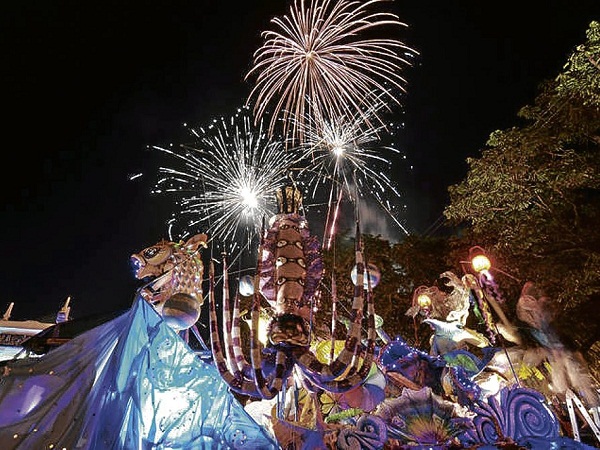
THE MAJICA MassKara features lighted floats that carry “sea and mountain creatures” to show that Bacolod is where the mountains and the sea meet. PHOTO BY DARYL ANTHONY JIMENEA
BACOLOD CITY—Works of art have taken center stage in this year’s MassKara Festival, which opened on Oct. 1 in Bacolod City.
Setting aside competition to work together to ensure the success of the festival, several artists designed the giant puppets, smiling masks, colorful costumes and sea and mountain creatures aboard lighted boats, leaving local and foreign tourists amazed.
“This festival is soaring on the wings of artists. They have consistently brought us out of the box to look beyond what is there, and this has animated the MassKara,” said festival director Eli Tajanlangit
“I think Bacolod is the first to consciously use art as a peg for its tourism … artists have made art accessible not just to the learned but to everyone, including children,” he added.
Floats and puppets
Dancers in smiling masks and colorful costumes parade on the catwalk during the fashion show at the Bacolod public plaza as part of the festivities of the 22-day MassKara Festival. PHOTO BY DARYL ANTHONY JIMENEA
The festival, which carries the theme “Life’s Good in Bacolod,” will reach fever pitch today and tomorrow when dancers in smiling masks and festive costumes take to the streets for a showdown. Adding to the revelry will be the performances of giant puppets.
Dancers from 11 schools are expected to perform today. Tomorrow, those from 15 barangays will battle it out in the dance and arena competitions on the main streets and at the public plaza.
At night, revelers will be treated to an Electric MassKara show of lighted floats and dancing puppets at The Tourism Strip on Lacson Street.
“Visitors can join what could be the biggest and longest street party in the Philippines when we close 18 blocks of our major highway,” Tajanlangit said. “They’ll also see a first—when we convert the entire city into a stage where seven simultaneous parades will happen featuring floats done by our artists.”
MassKara was coined from two words—“mass,” which means multitude, and “kara,” a Spanish word for face. For residents of Bacolod, it is a celebration and expression of thanks for the abundance of blessings life brings.
It rose from the gloom that enveloped the city in the 1980s when Negros Occidental was hit by a crisis brought about by a steep drop of prices of sugar in the world market. The depression was further aggravated when a Bacolod-bound vessel, MV Don Juan, sank on April 22, 1980, resulting in the deaths of about 700 people.
In the midst of the tragic events, artists, local government and civic groups decided to hold a “festival of smiles” as Bacolod was also known then as the “City of Smiles.”
Since its inception, the MassKara has slowly evolved into a collaborative work of local artists.
According to Mayor Evelio Leonardia, the festival has become not just a world-class event but also a “work of art” because of the artists’ collaboration.
THIS YEAR’S logo of MassKara Festival is a creation of nine artists based in Bacolod City. PHOTO BY DARYL ANTHONY JIMENEA
For instance, nine artists created this year’s festival logo. They are Emilio Montelibano, Susanito Samate, Claudine Joyce Ballesteros, J.R. Dellava, Guenievere Decena, Hilario Campos III, Roderick Tijing, Peter James Fantilago and Daryl Anthony Jimenea.
Except for Jimenea, each artist was assigned a letter from the word “MassKara” to design. Jimenea then put all the artworks together through computer digital works.
The letter “M” has a picture of a doña and a sacada on it, which signifies unity despite the difference in stature.
“A” has a tall building and a carabao, symbolizing urban and rural icons.
The first “S” has a roll of film since a lot of filmmakers come from the city. The other “S” has the bandstand of the plaza and fireworks to showcase the festival fun.
The letter “K” has a drawing of people with a mask in the center to show their unity. The “A” showcases other festivals in Bacolod.
The “R” speaks of the “royal” life in the city while the last “A” depicts two children, which means a bright future ahead for the city.
At least 800 students of La Consolacion College’s (LCC) School of Architecture, Fine Arts and Interior Design also created the giant puppets, which are at least 12 feet tall, including look-alikes of boxing icon Manny Pacquiao, Dolphy, Mayor Leonardia and characters from science fiction movies and novels, cartoons and mythical stories.
One puppet, dubbed “Empidol Tribute to Dolphy,” bested the rest and took the grand prize on Oct. 15.
This year, the giants have corresponding miniature replicas, which are on exhibit on the LCC campus.
Sea and mountain
Another collaborative work of artists—Charlotte Rodriguez, Neil Benavente, Karina Broce, Frelan Gonzaga, Will Sarabia, Rez Galvez and Joery Bais—is the Majica MassKara, which features two lighted floats that would carry “sea and mountain creatures” to show that Bacolod is where the mountains and the sea meet.
Acclaimed filmmaker Peque Gallaga conceptualized the floats while noted artist Charlie Co was show director.
The floats are executed by seven Bacolod artists.
Since it became an art event in 2004, the Majica MassKara has highlighted works of outstanding visual artists. These are meant to be set up in public places “as part of our commitment to infuse the MassKara Festival with works of public art, which, in turn, are meant to highlight Bacolod’s rich artistic heritage,” Tajanlangit said.
The festival will end tomorrow.